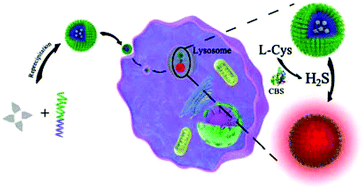Selective visualization of endogenous hydrogen sulfide in lysosomes using aggregation induced emission dots†
Abstract
The development of novel fluorescent probes for selective detection of endogenous hydrogen sulfide (H2S) in lysosomes is imperative for elucidating its functions associated with diseases. Nevertheless, the reported fluorescent probes for lysosomal H2S detection usually undergo an aggregation caused quenching (ACQ) phenomenon in the aggregate state and cause the self-quenching of fluorescence due to the “self-absorption” effect with a small Stokes shift, which largely limited their sensing application. To solve this problem, we present the aggregation induced emission dots (AIED) for selective visualization of endogenous H2S in lysosomes via a simple co-precipitation method. It is worth noting that AIED with excellent AIE properties and large Stokes shift (∼150 nm) could effectively prevent the notorious ACQ phenomenon and the self-quenching of fluorescence. In addition, the as-prepared AIED exhibits favorable features including good water dispersibility, high sensitivity (∼43.8 nM), outstanding selectivity toward H2S over other thiols, long-term stability (>15 weeks) and good biocompatibility. Significantly, the resultant AIED with good membrane permeability has been successfully employed to visualize the endogenous H2S in lysosomes in living cells. We expect that AIED can serve as a useful tool to investigate the roles of lysosomal H2S in H2S-associated diseases.



 Please wait while we load your content...
Please wait while we load your content...